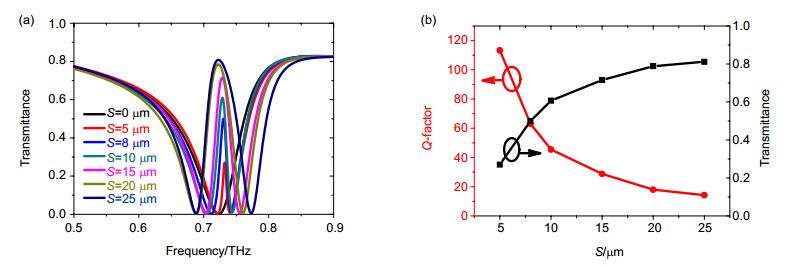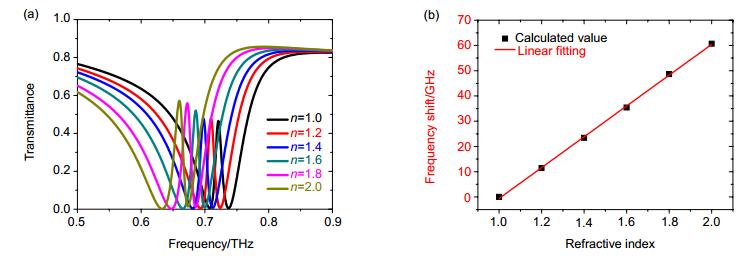High Q-factor terahertz metamaterial based on analog of electromagnetically induced transparency and its sensing characteristics
-
摘要
设计了一种具有类电磁诱导透明(EIT)效应的高Q值太赫兹超材料。该结构单元由上下平行的双金属线及中间垂直的单金属线组成。分别对单金属线、双金属线及组合结构进行仿真,分析了组合结构中金属线的位置和尺寸对透射率及品质因数Q的影响。结果表明,随着单金属线的水平移动产生了类EIT效应,透射率和Q值随着偏移距离的增大而发生变化,通过调整结构和尺寸可以实现不同Q值。通过优化,当偏移距离为8 μm时,在0.73 THz附近得到一个3 dB带宽约为11.56 GHz的透明窗,相应的Q值为63.09,其透射率为0.50。最后,对谐振器的传感特性进行了测量,其折射率灵敏度为60.69 GHz/RIU,FOM值为5.25/RIU,具有优异的传感特性。

Abstract
A high Q-factor terahertz metamaterial with analog of electromagnetically induced transparency (EIT) effect is designed. The structural unit is composed of double metal wires parallel to each other and a vertical single metal wire in the middle. The single wire, double wires and composite structures are simulated respectively, and the influence of the position and size of the metal wires on the transmittance and quality factor Q of the composite structure is analyzed. The results show that the EIT-like effect occurs with the horizontal shift of the single metal wire and the transmittance and the Q-factor are changed with the increase of the offset distance. Moreover, different Q-factor can be achieved by adjusting the structure and size. By optimization, when the offset distance is 8 μm, a transparent window with 3 dB bandwidth of approximate 11.56 GHz is obtained near 0.73 THz. The corresponding Q-factor is 63.09 and the transmittance is 0.50. Finally, the sensing characteristics of the resonator is measured, showing excellent sensing performance. The refractive index sensitivity is 60.69 GHz/RIU, and FOM value is 5.25/RIU.
-
Overview

Overview: A high Q-factor terahertz resonator with analog of electromagnetic induced transparency (EIT) effect is designed on the basis of metamaterial theory. The electromagnetic induced transparency (EIT) is a kind of quantum interference cancellation effect in an atomic system, which makes the opaque medium transparent to the probe. The resonator with the EIT-like effect has important applications in the refractive index sensing. However, the EIT-like metamaterial with tunable Q-factor is more practical. This paper presents a EIT-like terahertz metamaterial with tunable high Q-factor, which is composed of double metal wires parallel to each other and a vertical single metal wire in the middle. In practical applications, the MEMS structure can be used to change the position of the metal wire so as to achieve the purpose of regulating the Q-factor. The commercial simulation software CST is used to simulate the structure, in which the metal is Drude silver and the substrate material is selected by the organic glass. Furthermore, the propagation direction of the incident terahertz wave is perpendicular to the structure plane.
The wire structures can support the bright mode and dark mode. Through the radiation of the terahertz wave, the bright mode and dark mode are excited directly and indirectly to form resonances. The resonance spectrum superposition between the units forms the cancellation interference to make the plane metamaterial transparent to the incident terahertz wave. The simulation of the bright mode, the dark mode, the symmetric structure, and asymmetric structure are carried out respectively. By analyzing the response of the electric field and the magnetic field, the interaction between them is studied in detail, and the influence of geometric structure and size on the transmittance and the quality factor in the asymmetric condition is also analyzed. The results show that the EIT-like effect occurs with the horizontal shift of the single metal wire and the transmittance and the Q-factor are changed with the increase of the offset distance. Moreover, tunable Q-factor can be achieved by adjusting the structure and size. By optimization, when the offset distance is 8 μm, a transparent window with 3 dB bandwidth of approximate 11.56 GHz is obtained near 0.73 THz. The corresponding Q-factor is 63.09 and the transmittance is 0.50. Finally, the sensing characteristics of the resonator is measured, showing excellent sensing performance. The refractive index sensitivity is 60.69 GHz/RIU, and FOM value is 5.25/RIU.
-

-
图 6 (a) L1=L3取不同值时透射率的变化;(b) L2取不同值时透射率的变化;(c) W不同取值对透射特性的影响;(d) W不同取值时Q值和透射率的变化
Figure 6. (a) Change in transmittance at different values of L1=L3; (b) Change in transmittance at different values of L2; (c) The influence of transmission characteristics at different values of W; (d) Change in Q-factor and transmittance at different values of W
-
参考文献
[1] Lukin M D, Imamoğlu A. Controlling photons using electromagnetically induced transparency[J]. Nature, 2001, 413(6853): 273-276. doi: 10.1038/35095000
[2] Fleischhauer M, Imamoglu A, Marangos J P. Electromagnetically induced transparency: optics in coherent media[J]. Reviews of Modern Physics, 2005, 77(2): 633-673. doi: 10.1103/RevModPhys.77.633
[3] Vafapour Z, Alaei H. Subwavelength micro-antenna for achieving slow light at microwave wavelengths via electromagnetically induced transparency in 2D metamaterials[J]. Plasmonics, 2017, 12(5): 1343-1352. doi: 10.1007/s11468-016-0392-1
[4] Vafapour Z, Alaei H. Achieving a high Q-factor and tunable slow-light via classical electromagnetically induced transparency (Cl-EIT) in metamaterials[J]. Plasmonics, 2017, 12(2): 479-488. doi: 10.1007/s11468-016-0288-0
[5] Zhang S, Genov D A, Wang Y, et al. Plasmon-induced transparency in metamaterials[J]. Physical Review Letters, 2008, 101(4): 047401. doi: 10.1103/PhysRevLett.101.047401
[6] Pu M B, Hu C G, Huang C, et al. Investigation of Fano resonance in planar metamaterial with perturbed periodicity[J]. Optics Express, 2013, 21(1): 992-1001. doi: 10.1364/OE.21.000992
[7] He X J, Wang L, Wang J M, et al. Electromagnetically induced transparency in planar complementary metamaterial for refractive index sensing applications[J]. Journal of physics D: Applied Physics, 2013, 46(36): 365302. doi: 10.1088/0022-3727/46/36/365302
[8] 韩昊, 武东伟, 刘建军, 等.一种太赫兹类电磁诱导透明超材料谐振器[J].光学学报, 2014, 34(4): 0423003. http://www.cnki.com.cn/Article/CJFDTOTAL-GXXB201404040.htm
Han H, Wu D W, Liu J J, et al. A terahertz metamaterial analog of electromagnetically induced transparency[J]. Acta Optica Sinica, 2014, 34(4): 0423003. http://www.cnki.com.cn/Article/CJFDTOTAL-GXXB201404040.htm
[9] Liu C X, Liu P G, Bian L, et al. Dynamically tunable electromagnetically induced transparency analogy in terahertz metamaterial[J]. Optics Communications, 2018, 410: 17-24. doi: 10.1016/j.optcom.2017.09.084
[10] Guo Y H, Yan L S, Pan W, et al. Electromagnetically induced transparency (EIT)-like transmission in side-coupled complementary split-ring resonators[J]. Optics Express, 2012, 20(22): 24348-24355. doi: 10.1364/OE.20.024348
[11] He Xunjun, Zhang Qinfeng, Lu Guangjun, et al. Tunable ultrasensitive terahertz sensor based on complementary graphene metamaterials[J]. RSC Advances, 2016, 6: 52212-52218. doi: 10.1039/C5RA21974D
[12] Lei Wang L, Li T Y, He X J. Switching electromagnetically induced transparency in reconfigurable terahertz metamaterials[J]. Integrated Ferroelectrics, 2015, 161(1): 45-50. doi: 10.1080/10584587.2015.1035194
[13] Prakash Pitchappa P, Manjappa M, Ho C P, et al. Active control of electromagnetically induced transparency analog in terahertz MEMS metamaterial[J]. Advanced Optical Materials, 2016, 4(4): 541-547. doi: 10.1002/adom.v4.4
[14] 唐雨竹, 马文英, 魏耀华, 等.一种旋转可调的太赫兹超材料及其传感特性[J].光电工程, 2017, 44(4): 453-457. doi: 10.3969/j.issn.1003-501X.2017.04.010
Tang Y Z, Ma W Y, Wei Y H, et al. A tunable terahertz metamaterial and its sensing performance[J]. Opto-Electronic Engineering, 2017, 44(4): 453-457. doi: 10.3969/j.issn.1003-501X.2017.04.010
[15] Chiam S Y, Singh R, Rockstuhl C, et al. Analogue of electromagnetically induced transparency in a terahertz metamaterial[J]. Physical Review B, 2009, 80(15): 153103. doi: 10.1103/PhysRevB.80.153103
[16] Liu X J, Gu J Q, Singh R, et al. Electromagnetically induced transparency in terahertz plasmonic metamaterials via dual excitation pathways of the dark mode[J]. Applied Physics Letters, 2012, 100(13): 131101. doi: 10.1063/1.3696306
[17] 孙雅茹, 史同璐, 刘建军, 等.太赫兹超材料类EIT谐振无标记生物传感[J].光学学报, 2016, 36(3): 0328001. http://www.cnki.com.cn/Article/CJFDTOTAL-GXXB201603036.htm
Sun Y R, Shi T L, Liu J J, et al. Terahertz label-free bio-sensing with EIT-Like metamaterials[J]. Acta Optica Sinica, 2016, 36(3): 0328001. http://www.cnki.com.cn/Article/CJFDTOTAL-GXXB201603036.htm
[18] 郑伟, 范飞, 陈猛, 等.基于太赫兹超材料的微流体折射率传感器[J].红外与激光工程. 2017, 46(4): 0420003. http://d.old.wanfangdata.com.cn/Periodical/hwyjggc201704018
Zheng W, Fan F, Chen M, et al. Terahertz refractive index sensing of microfluid based on metamaterials[J]. Infrared and Laser Engineering, 2017, 46(4): 0420003. http://d.old.wanfangdata.com.cn/Periodical/hwyjggc201704018
-
访问统计


 E-mail Alert
E-mail Alert RSS
RSS

 下载:
下载:










